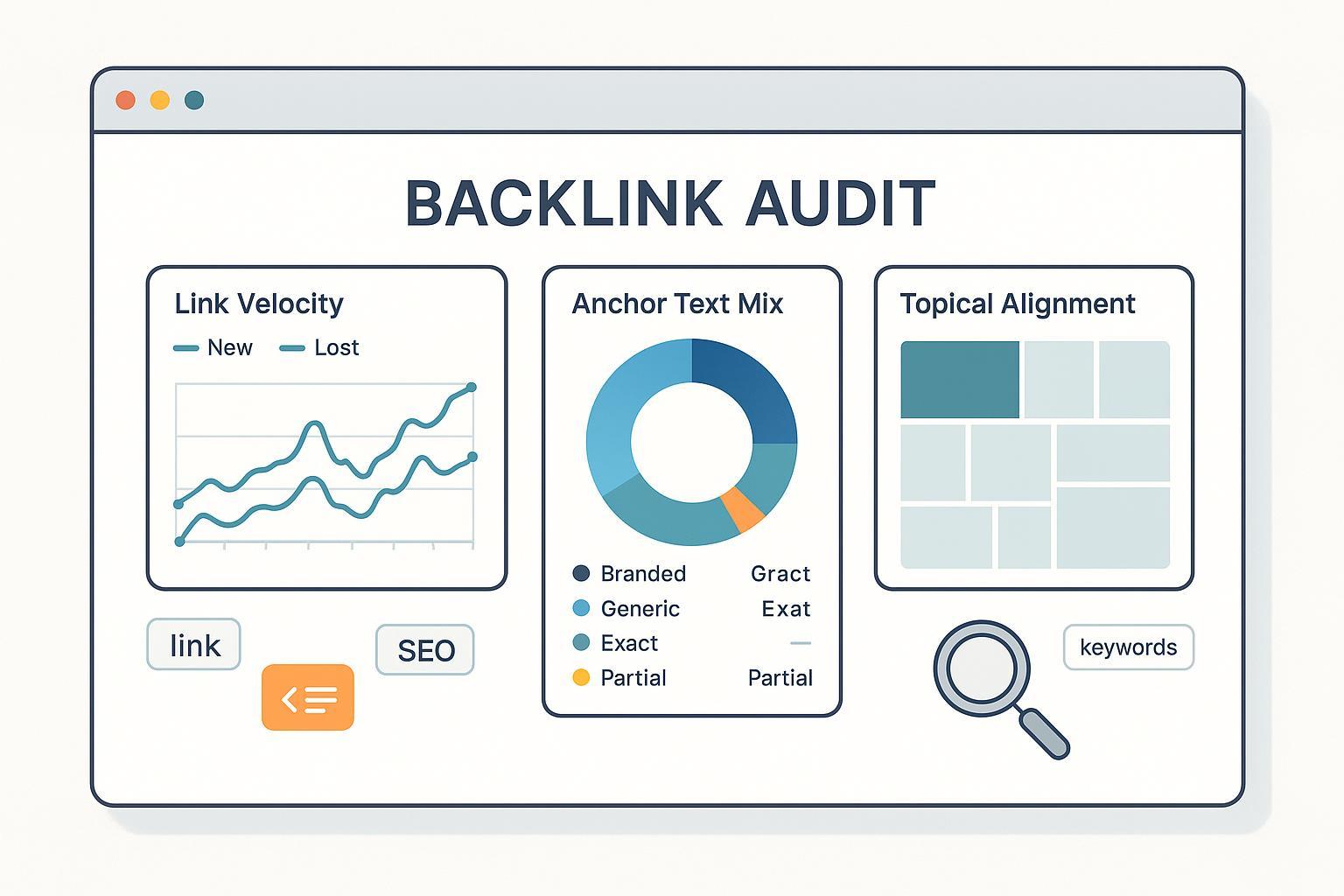How to Run a Link Audit: Steps for Velocity, Anchors & Relevance
Learn step-by-step how to audit backlinks for link velocity, anchor text diversity, and topical alignment. Spot risks, improve SEO, and maintain a healthy backlink profile.


A solid backlink profile should grow in a natural rhythm, use anchors that help users, and come from thematically relevant sources. In this hands-on tutorial, you’ll build a practical audit workflow to evaluate three pillars of backlink health: link velocity (new/lost trends), anchor text diversity, and topical alignment. Expect a compliance-first approach grounded in Google’s guidance, with clear decision points and troubleshooting for ambiguous signals.
- Difficulty: Intermediate
- Time: 2–6 hours for a full first audit (site size dependent)
- Prerequisites: Access to Google Search Console and at least one third‑party link index (Ahrefs, Semrush, Moz, or Majestic)
- Guardrails: Follow Google’s policies on link spam and link schemes; reserve the disavow tool for significant unremovable spam.
Note on “link velocity”: Google hasn’t documented link velocity as a ranking factor. Treat it as a monitoring dimension to spot suspicious patterns, not a lever to manipulate rankings. For background context, see the practical framing in the Search Engine Land link velocity guide.
Step 1: Collect and Normalize Your Link Data
Your conclusions are only as good as your data. Start by aggregating links across sources to reduce blind spots.
-
Export from Google Search Console (GSC):
- Open GSC > Links > Export “External links” (Top linked pages, Top linking sites, Top linking text).
- GSC is your baseline of links Google reports; it won’t include everything, but it’s authoritative for what Google currently sees.
-
Export from a third‑party tool:
- Use Ahrefs, Semrush, Moz, or Majestic to pull backlinks, referring domains, and anchors. Export at the page level and domain level.
-
Create a master spreadsheet or database:
- Consolidate columns: source tool, referring domain, linking URL, target URL, first seen date, last seen date, link type (follow/nofollow/sponsored), anchor text, and any topical/category metadata.
- Deduplicate by the linking URL and normalize URLs (account for canonicalization and redirects).
- Choose a common time frame (e.g., monthly bins) for velocity analysis.
Tip: Keep an audit log. Record decisions (e.g., “outreach sent,” “disavow prepared”) and evidence. This speeds up reconsideration requests if needed.
Step 2: Audit Link Velocity (New vs. Lost Over Time)
You’ll look for natural growth, explainable spikes, and concerning drops. Think of this like monitoring vital signs rather than chasing a number.
-
Build a time-series chart:
- Plot new and lost referring domains per week or month; apply a moving average (7–30 days) to smooth noise.
- Segment by link type (follow vs. nofollow/sponsored) and by source quality (you can use your tool’s domain metrics directionally, not as hard rules).
-
Interpret patterns with context:
- Natural signals: Moderate, steady growth; spikes tied to explainable events (new content launch, PR coverage, a viral post); diverse sources and anchors.
- Potentially unnatural signals: Sudden spikes without a clear event; surges from unrelated or low‑quality domains; anchors that heavily skew to exact‑match commercial terms.
- Negative velocity: A sustained increase in lost links. Investigate URL changes, deindexing, or site migrations.
-
Cross-check against events:
- Maintain a simple “campaign notes” log. If you see a spike, you should be able to point to a press hit, product release, or content launch. If you can’t, dig deeper.
Compliance reminder: Google’s spam policies on link spam explain manipulative patterns (buying/selling links, automated creation, excessive exchanges). Your velocity review should help surface clusters that might match those behaviors.
Troubleshooting:
- Unexplained spike: Segment new links by domain quality and topical relevance; manually inspect a sample. If many are low‑quality or off‑topic, consider negative SEO or vendor activity. Initiate outreach; reserve disavow for unremovable, egregious clusters.
- Lost‑link surge: Identify affected URLs; check migrations and canonical changes; implement 301s to relevant equivalents and monitor recovery.
Step 3: Audit Anchor Text Diversity
Anchors should help users and search engines understand the destination. Over‑optimized anchors are a classic risk signal.
-
Classify anchors:
- Branded (your brand name), URL/naked (example.com), generic (“learn more”), exact match (precise keyword), partial match (keyword variant), phrase/broad match, and image (alt text used as anchor).
- If you want a primer on types and best practices, the Moz anchor text overview is a useful reference.
-
Analyze distributions:
- For your key landing pages, calculate the proportion of each anchor category. You’re not chasing a fixed ratio; you’re looking for healthy variety.
- Red flags include a high concentration of exact‑match commercial anchors, especially from low‑quality or unrelated domains.
-
Verify anchor descriptiveness:
- Per Google’s guidance, make links crawlable and use descriptive anchors that reflect the destination content. See Google’s links and anchor text best practices.
-
Plan remediation if needed:
- Pause campaigns producing keyword‑stuffed anchors.
- Earn more branded, generic, and naturally phrased anchors through useful content and genuine editorial mentions.
- Request edits where possible; if links are clearly manipulative and unremovable, consider disavow (see Step 5 for criteria).
Tip: Context matters. A single exact‑match anchor on a highly relevant editorial page can be fine; dozens from low‑quality directories are not.
Step 4: Audit Topical Alignment (Domain and Page Level)
You’re checking whether link sources fit your site’s themes and whether the linking page’s content aligns with the target page.
-
Domain-level lens:
- Use your tool’s topical/category views or Majestic’s Topical Trust Flow directionally to see dominant categories for referring domains.
- Prioritize domains whose topical focus aligns with your site’s core themes.
-
Page-level context:
- Open the linking pages and skim the surrounding content, the section containing your link, and the anchor.
- Ask: Does this page’s subject matter genuinely complement the destination page’s intent?
-
Manual review for edge cases:
- Thin pages, irrelevant directories, template‑footer links, or off‑topic guest posts are frequent risk zones. Flag and sample review.
-
Synthesis and triage:
- High‑quality, topically aligned domains/pages: keep and cultivate.
- Off‑topic clusters or low‑quality sources: plan outreach to remove or nofollow; consider disavow only if clearly manipulative and unremovable.
Note: Topical alignment is nuanced. Don’t discard legitimate coverage from adjacent industries if the context is clearly relevant.
Step 5: Triaging Actions (Removal, Disavow, and Reclaiming Equity)
Act carefully and document everything. When in doubt, favor outreach and content improvements over aggressive disavow.
-
Outreach/removal first:
- For paid/sponsored links, ensure they use rel="sponsored" or rel="nofollow" per Google’s link schemes policy.
- For manipulative or irrelevant placements, request removal or anchor edits and log attempts.
-
Disavow only when warranted:
- Use Google’s disavow tool if you have a significant number of spammy/unnatural links you cannot remove. Read the official guidance: Google Disavow Links.
- If you received a manual action, clean up and then submit a reconsideration request with evidence (see Google Manual Actions overview).
-
Preparing a minimal, precise disavow file:
- Prefer domain-level entries for spammy networks you can’t prune link-by-link.
- Include comments starting with # to document reasons.
# Unremovable spammy directory cluster domain:spam-directory-example.com domain:lowquality-pbn-example.net # Sitewide footer links from templated theme domain:templates-example.org -
Reclaim lost link equity:
- If valuable links point to moved or 404 pages, implement permanent redirects to the most relevant equivalents and verify indexing.
- For a practical walkthrough, see this guide on mastering 301 redirects.
Tooling note: For planning content that earns naturally aligned links and maintaining topical consistency across clusters, you can use QuickCreator to outline and publish evergreen posts with SEO hygiene. Disclosure: QuickCreator is our product.
Step 6: Prevention and Policy Guardrails
Prevention reduces future cleanup. Establish simple rules and stick to them.
- Content that earns links: Build topic clusters and evergreen assets that attract editorial mentions from relevant sites. For practical tips, review this primer on creating evergreen content that boosts SEO.
- Qualify paid/sponsored links: Use rel="sponsored"/"nofollow" consistently; avoid keyword‑stuffed anchors in distributed content (press releases, guest posts).
- Site hygiene: Keep a clean CMS setup, resolve 404s quickly, and ensure crawlable, descriptive internal links. See this CMS SEO best practices checklist.
- Policy reference: Revisit Google’s spam policies on link spam and links/anchor guidance during quarterly reviews.
Step 7: Reporting the Audit and Setting a Monitoring Cadence
Turn your findings into a concise, actionable report—then keep an eye on the vitals.
- Velocity snapshot: Include charts of new vs. lost referring domains (monthly), highlight explainable events and any suspicious clusters.
- Anchor mix: Show distributions for key landing pages; note pages with over‑optimized anchors and your remediation plan.
- Topical map: Summarize domain‑level categories and page‑level relevance notes; list priority outreach targets.
- Action log: Document outreach, removals/edits, disavow entries (if any), and redirect fixes.
- Cadence: Review monthly for active campaigns or quarterly for steady‑state sites. Maintain a “campaign notes” timeline to explain spikes.
Encouragement: If you’ve completed the first pass of velocity, anchors, and topical checks, you’ve covered the hardest part. The ongoing cadence is lighter and mostly verification.
Quick Troubleshooting Playbook
-
Velocity spike with no clear event
- Segment links by domain quality and topic; sample inspect. Outreach for removals where appropriate; avoid blanket disavow.
-
Over‑optimized anchors on a money page
- Pause campaigns that produce keyword‑stuffed anchors; earn more branded/contextual anchors; request edits; keep anchors descriptive per Google’s guidance.
-
Irrelevant backlink cluster from one domain or network
- Verify manipulative patterns (directories, spun content). Request removal; if uncooperative and clearly spammy, consider domain‑level disavow.
-
Conflicting counts across tools
- Sample‑verify links. Different tools have different crawl coverage; use multiple sources to reduce blind spots and retain GSC as a baseline.
Compliance References (for deeper reading)
- Google Search Central: Spam policies on link spam
- Google Search Central: Links and anchor text best practices
- Google Support: Link schemes (paid/sponsored links)
- Google Support: Disavow Links tool guidance
- Google Support: Manual actions and recovery
- Search Engine Land: What is link velocity?
- Moz: Anchor text overview
By following this workflow, you’ll be able to identify unnatural velocity patterns, anchor over‑optimization, and topical mismatches, take compliant action, and set up a monitoring rhythm that keeps your backlink profile healthy over time.





